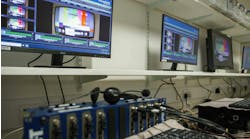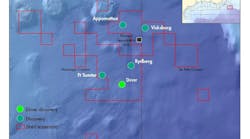Formed in late 1994, Kvaerner Subsea Projects (KSP) was designed to offer an integrated package of services and equipment from various companies within the Kvaerner Oil & Gas group. In a strategic alliance, partnership, or on a turnkey project basis, KSP provides complete packaged subsea production systems including installation when appropriate.
A client's planning and management time can be dramatically reduced along with project completion time. The experience base of the client and Kvaerner are melded to insure efficient project operation and optimized system design.
Richard Cain, KSP president, explains: "Although KSP will provide single-source responsibility for subsea production systems in other areas of the world, we are especially committed to US Gulf of Mexico operations. We feel our installation management and construction experience, coupled with the extremely broad range of services and equipment available from Kvaerner's many subsidiary companies, puts us in a unique position. Seldom will we go outside Kvaerner to source a project's needs."
Most US Gulf projects will involve wellheads, trees, completion, and riser systems from Kvaerner National; steel-tube umbilicals, control and intervention equipment, and other subsea control services from Kvaerner FSSL. A half dozen other Kvaerner companies may also be involved in a specific project, especially as Kvaerner bolsters its technology base for the US Gulf.
Projects currently being evaluated include adding US-fabricated umbilicals and modular manifold systems for both shallow and deepwater applications. Customers will also be able to draw on Kvaerner Process Systems, which supplies topside production-process equipment.
Other services
Other services to be provided to US Gulf of Mexico operators by Kvaerner divisions include the following:
- Mudline completion: In order to save US Gulf operators the cost and time of mobilization and demobilization, Kvaerner National of Houston is keeping in stock in Houston a 3-in. 5,000 psi mudline completion system designed and tested to AOPI 17D specifications and complete with running tools.
The company is also stocking forgings for key components to allow rapid delivery of other sizes and pressure ratings. All systems include the control-equipment interface, and running tools are available for lease.
- Pull-in connection: Also of interest to US Gulf operators is the new RTS ROV-operated Tie-In System from Kvaerner Energy in Norway and handled by Kvaerner National. The diverless system is designed for water depths to about 3,300 ft and handles 10-in. 3,000 psi or 9-in. 5,000 psi flexible flowlines.
Major advantages of the system include minimum effect from water depth, the use of simple and low-cost installation vessels, and minimum equipment left subsea. Support structures can be smaller than typically required, the control system is simple and straightforward, and various launching methods are accommodated. System reliability is enhanced by use of proven designs for the clamp, hub, and reel assemblies. No line orientation is needed during laying for either single or multi-bore lines.
The net result for a user is reduced total field-development costs and only about 3-4 hours for each tie-in operation with leased tools. Satellite christmas trees can be connected directly without a flowspool or vertical connector, The system complements particularly well side-valve through-bore trees where the tree will seldom have to be pulled since the tubing hanger can be pulled independently.
Satellite trees directly below a floating-production system (FPS) using flexible risers can be similarly connected. Risers can be installed and replaced without interrupting FPS production. Tie-in can be performed in parallel with other FPS operations without requiring expensive vessel time.
The compact, modularized system uses modules small enough to be run through a moonpool. The small sizes and light weights of tie-in structures are vital to successful use in such applications.
- Splitter wellhead: The splitter wellhead systems, developed in conjunction with a major oil company and being offered to the industry by Kvaerner National of Houston are meeting claims of cost and time savings for operators. The design allows two or more wells to be drilled and completed from a single wellbore. The cost, time, and trouble in adding conductors are eliminated. Each well can be produced, serviced, and worked over independently.
Splitter systems combine with a unique 1-4 cam and riser-latch assembly developed by Baker Oil Tools. Installed at the surface-casing base, it allows drilling-riser orientation and isolation of well bores. Once set, it eliminates the need to again drill this portion of the hole - thus saving rig time, crossover time, and rig moves.
Splitter system advantages are especially attractive to US Gulf of Mexico operators for minimum-concept platforms, monopod platforms, and subsea developments. For exploration and delineation work, a second well can be drilled without having to open-hole sidetrack the first well and give up discovered reserves.
Platform size can be reduced, and the number of wells that can be drilled and serviced from existing platforms can be increased.
The Surface Splitter wellhead system is most attractive for use at surface-setting depths. It eliminates the need for downhole separation tools and thus makes the technology more economic than conventional methods for environmentally sensitive onshore and inland water locations. It complements the Downhole Splitter wellhead system, which is usually the best choice for intermediate casing-setting depths.
Copyright 1995 Offshore. All Rights Reserved.


